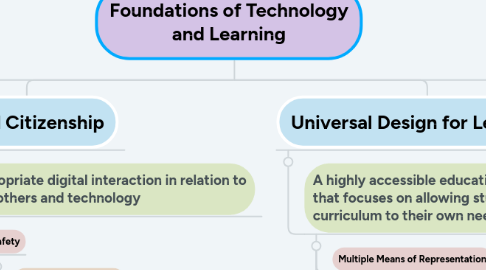
1. Copyright Law
1.1. The legal right of a creator to copy, distribute, perform and/or display a work
1.1.1. Basics
1.1.1.1. Everything captured in a fixed format is copyrighted
1.1.1.2. Copyright lasts the entirety of the creator's lifetime, plus seventy years
1.1.2. Fair use
1.1.2.1. Applies to commentary, news reporting, parody and education
1.1.2.2. Purpose and character
1.1.2.2.1. Not intended for financial gain
1.1.2.3. Nature of the work
1.1.2.3.1. Factual works instead of creative works
1.1.2.4. Amount and substantiality
1.1.2.4.1. Not the entire work and not the heart of the work
1.1.2.5. Commercial Impact
1.1.2.5.1. Does not cause economic loss to the creator
1.1.3. Purpose
1.1.3.1. To promote progress by allowing creators to benefit from their work
2. Digital Citizenship
2.1. Appropriate digital interaction in relation to self, others and technology
2.1.1. Safety
2.1.1.1. Students should know:
2.1.1.1.1. What information they should not share online
2.1.1.1.2. How to distinguish trustworthy digital tools from their counterparts
2.1.1.1.3. To protect themselves by always being appropriate
2.1.1.1.4. To speak up when something is amiss
2.1.2. Savvy
2.1.2.1. Students should know:
2.1.2.1.1. Technological basics
2.1.2.1.2. How to navigate technology so they can keep up with the pace of change
2.1.3. Sociability
2.1.3.1. Students should know:
2.1.3.1.1. How to interact positively with their peers
2.1.3.1.2. How to engage in discussion with those who think differently without being inappropriate
3. Universal Design for Learning
3.1. A highly accessible educational practice that focuses on allowing students tailor the curriculum to their own needs
3.1.1. Multiple Means of Representation
3.1.1.1. Provide options for how information is presented, as opposed to presenting information in one way (like in a lecture) makes this information more accessible to students
3.1.2. Multiple Means of Action and Expression
3.1.2.1. Provide options for how students express what they have learned
3.1.3. Multiple Means of Engagement
3.1.3.1. Provide options for how students can engage with the information so that they are interested and motivated
4. Theoretical Foundations
4.1. Educational philosophyfoundations
4.1.1. Behaviorism
4.1.1.1. Behavior is a call and response
4.1.1.1.1. A stimulus is presented, and a certain response is given without regard to thought processes
4.1.2. Cognitivism
4.1.2.1. Active processing
4.1.2.1.1. Responses are based on thought processes which are based on prior knowledge and reinforcements
4.1.3. Constuctivism
4.1.3.1. Experiential learning
4.1.3.1.1. Our learning process is based on our own understanding of the world around us

